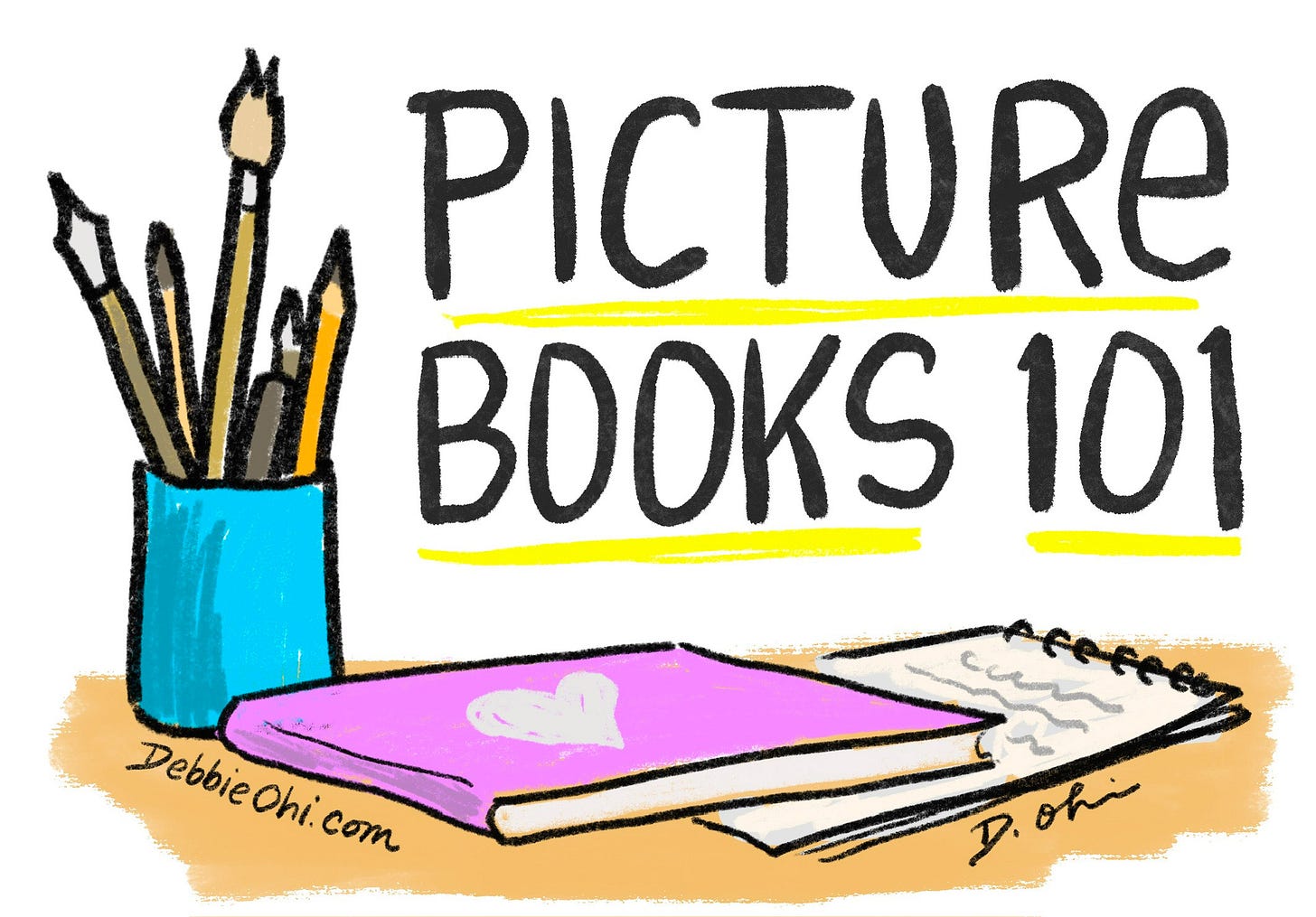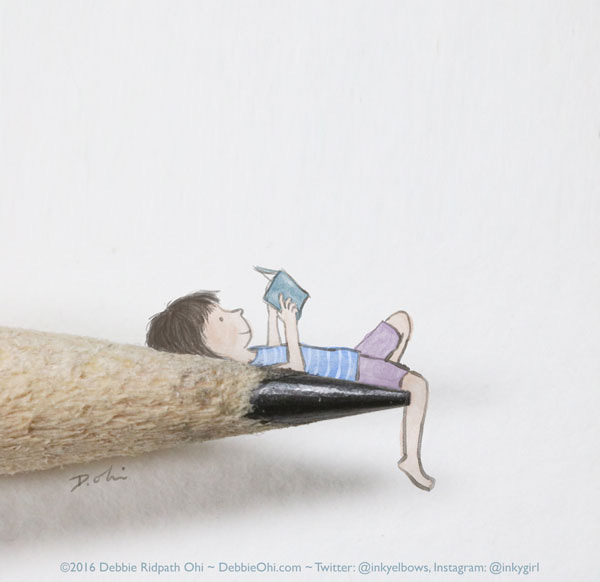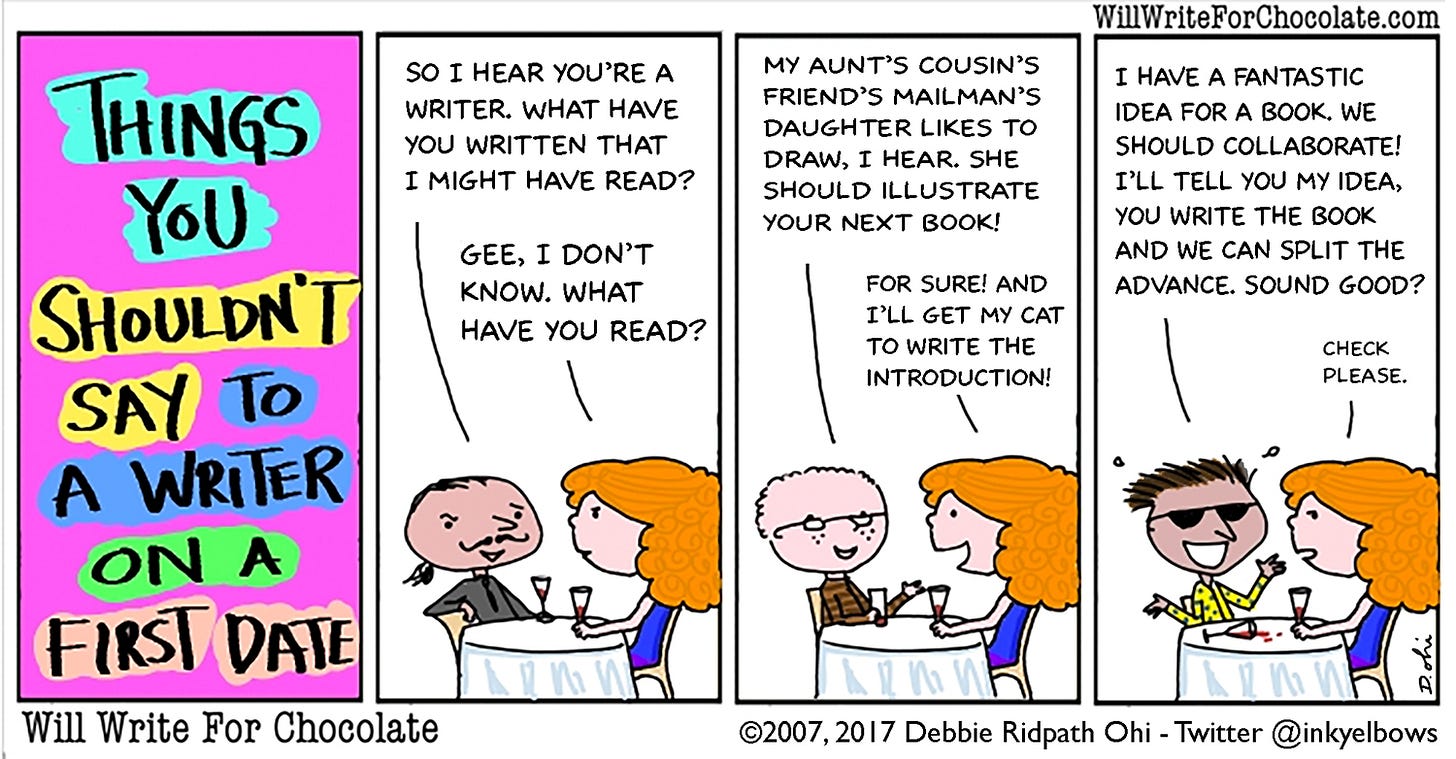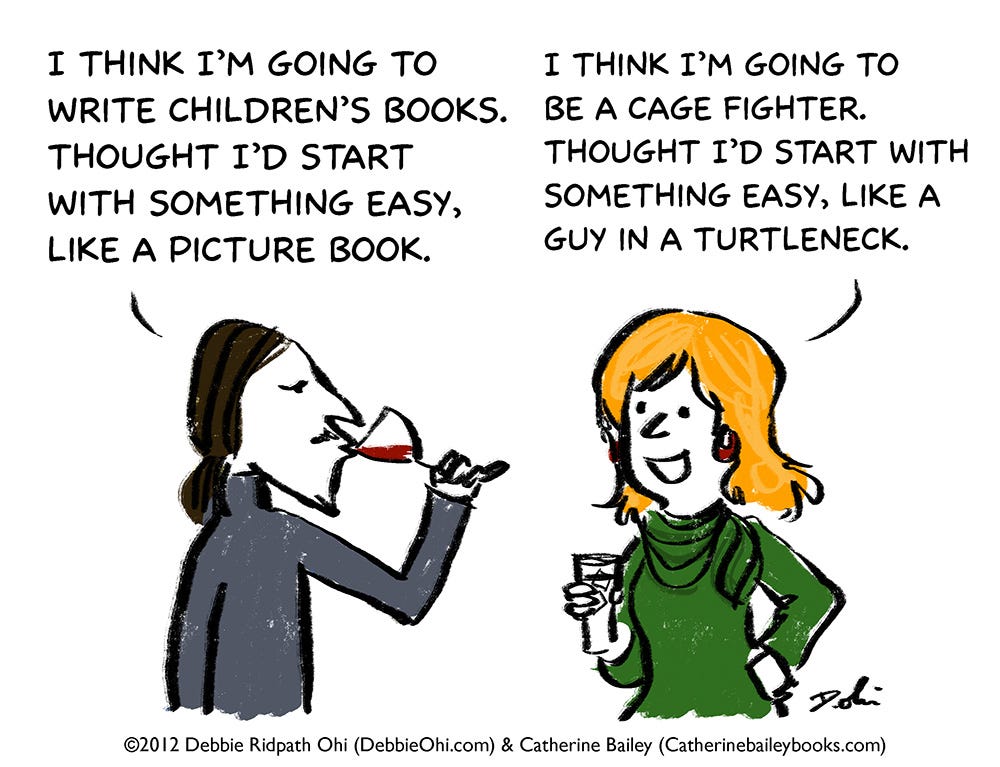Picture Books 101 (Part 1): Getting Started
Want to write or illustrate children’s books someday? Here’s some advice.
Hi, I’m Debbie Ridpath Ohi! Welcome to the first part of my Writing and Illustrating Picture Books 101 post series, which I plan to send out twice a month.
I’ve been creating picture books for over a decade, working with publishers like Simon & Schuster, Random House, and HarperCollins. Before then, I wore many hats but mainly focused on writing. Since my picture book writer/illustrator career began, I’ve been gradually learning about the craft and business, and I plan to share what I’ve learned.
READ. Read widely and voraciously, especially in the genre you hope to write or illustrate. I come across far too many hopeful picture book writers who are only familiar with books from their childhood and aren’t familiar with what is being published now. That’s not to say that you should avoid the classics! If one of your goals is to be published by one of the traditional publishing houses (rather than self-publishing), be aware that what was published back when you were growing up does not necessarily reflect what publishers are looking for now.
THERE IS A TON OF INFO ALREADY AVAILABLE ONLINE. Don’t be lazy. When I started (yes, I am Old), I went to the library to look up info. There was no World Wide Web. It drives me a wee bit crazy when strangers email me and say stuff like, “I’m thinking about writing children’s books. Could you point me in the right direction?” because it means they either haven’t bothered to do any research on their own or what they’re really asking me is, “Would you help me get published?”
Nowadays, SO much information about the craft and business is available online. I recommend joining organizations like SCBWI and CANSCAIP (Canada), where you’ll not only be able to find a wealth of resources (especially check out SCBWI’s The Book: The Essential Guide To Publishing For Children) but also find opportunities to meet others in the community.
However, I understand it can get overwhelming. Hence, my Picture Books 101 newsletter. My goal is to convey what I’ve learned over the years in condensed nuggets, based on my own experience and the questions I tend to get asked the most often.
REMEMBER THAT KIDS ARE SMART. One of the most common mistakes I’ve seen in picture book manuscripts from beginning writers: having a story that is overly message-y, pushing a lesson that the author or author-illustrator wants young readers to learn. If a young reader senses that they are being lectured to, they are less likely to be interested. This means that parents, guardians and educators are less likely to buy the book. Which means that editors are less likely to want to acquire your story.
JUST BECAUSE YOUR GRANDKIDS / NEIGHBOR’S CHILDREN / STUDENTS LOVE YOUR STORY DOESN’T MEAN IT’S READY TO SEND OUT TO PUBLISHERS. Again…if you’re self-publishing, then it’s a different story. For a publisher to want to invest money, however, your book needs to be as polished as possible and have a reasonable chance of appealing to book buyers. Again, read lots of picture books, especially ones that have been published in the past five years. Your story about a child who doesn’t fit in at school but learns to embrace their differences may have a great underlying message BUT you need to find a way to make yours stand out from the hundreds of other picture books with a similar message.
DON’T ASSUME THAT SHORT = EASY. So many people think that short = easy, especially when it comes to picture books. And while yes, while it’s easy to crank out a picture book manuscript in terms of word count, writing a picture book story that a publisher will want to acquire is an entirely different animal. At this point, I can imagine many of you leaping up and saying, “You shouldn’t worry about the market! Just write the story that you were meant to write!” I partly agree. However, if your goal is to be published by a traditional publishing house, then I strongly advise you to go to the local children’s bookstore and library; I guarantee you will save yourself much heartache and wasted effort. Familiarise yourself with what’s being published. Let yourself fall in love with some of these picture books and then ask why you enjoy them. Yes, I know I already mentioned reading picture books at the beginning of the post. READ LOTS OF PICTURE BOOKS.
CONNECT WITH THE COMMUNITY. Writing and illustrating are solitary activities, but trying to get published does not have to be. I wish someone had told me this when I first started. Be sure to seek out fellow kidlit creators in your local community. The SCBWI has regional chapters worldwide, and Canadians should check out CANSCAIP. I received my first children’s picture book contract when my editor at Simon & Schuster came across my work at an SCBWI Summer Conference.
DEVELOP A THICK SKIN, BE OPEN TO CRITICISM. So much about publishing industry success has to do with intelligent perseverance. You will encounter many forms of criticism during your career, before and after publication (including critiquing, reviews, solicited and unsolicited feedback, etc.). There may be times when you feel overlooked and ignored. Developing a thick skin early on and learning how to cope will help you weather the ups and downs of the publishing industry and help you focus on your long-term goals.
👉🏼 In Part 2, I’ll start getting into the nitty-gritty.
Substack newsletters that might interest you
The following are just a few newsletters I’ve found on Substack where kidlit book creators share their process. Some have paywalls.
- by Adam Ming. Read How I Became A Picturebook Illustrator - by James Burks, graphic novels for young people - by Amy Makechnie novels for young people - by Meaghan McIsaac, novels for young people - by Melanie Conklin, novels for young peopleI’ll be recommending more in future newsletters! Feel free to suggest others in the comments.
I’d love to hear from YOU…
What topics relating to writing and illustrating picture books most interest you? Any specific questions you’d like me to talk about? Topics I plan to cover in upcoming issues: picture book format, whether or not to include art notes, portfolio tips, how to use thumbnail storyboards to check pacing and arc, agents, submission tips, and more. In addition to beginner questions, I also welcome suggestions for more advanced topics.
Thank you for reading! I’m just starting here on Substack, so if you enjoyed this post, I’d be grateful if you could help spread the word. I welcome suggestions about what you’d like me to write about in upcoming issues.











Debbie, I have been reading and rereading PB 101. And following the recommended links. I’m enjoying my deep dive into current picture books as wll as revisiting “the classics". The local children’s librarians have been so helpful. They are great resources. I’m also fortunate to have an active SCBWI group for support and helpful critiques.
This is such a fun find — thank you for sharing so openly and generously! I'm the person who thought short = easy, and one year after coming up with my brilliant 32-page picture book idea, I still haven't nailed it. The most humbling experience! :)